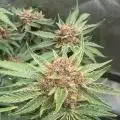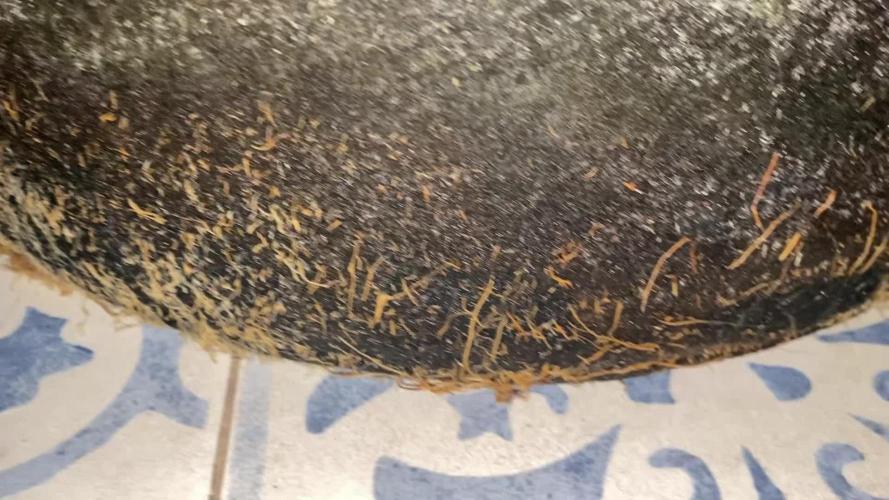The Grow Awards 2026 🏆 







































Likes
Comments
Share


@Die_Growbox
Follow
Nährstoffe bekomme ich nicht geregelt Blätter werden gelb von umtern nach oben gegossen wird nach gieß Plan von growers .ch mit Leitungswasser
Ph werde Erde 5,5-6,5
Da die Feuchtigkeit nicht gesenkt werden konnte sind jetzt nur noch 3 Pflanzen im Zelt
Likes
1
Share


@Timmyg91
Follow
The in house genetics seed is grow rapidly almost similar to a autoflowers
Both plants getting flipped on sunday
Likes
30
Share


@Green_Dream
Follow
The bananas are quite progressive, they were like this from the start, they are one node ahead of their sisters. Planning to top them at the 6th node this time and give around 5-6 weeks of veg.
Processing
Likes
25
Share


@Cannibalgardens
Follow
Well I have away the #seedstockers to a friend in need .. The rest are all doing great for week 2 ..The @sweetseeds @futuregenetix and @originalsensible with the @dinafem will be grown indoors and the other @seedsman will be outdoors this year ... They are all very healthy and happy another week or so and they will get there transplant done .. and then we vegetation for a while ...
Likes
13
Share


@Herbz_Unkraut
Follow
what a resin monster! such beautiful plants! one of the 2 phenos had straight peanutbutter flavor!
Likes
12
Share


@Kenpowarrior
Follow
●on 12/12 light so that honey girls can start to flowering. They are no auto's.
●Royal dwarf girls are on green sensation and sugar royal for better tast en smell. Lets see what it gives.
●they are growing slow now not much change to see. Waiting for fatter buds.
Likes
12
Share


@mowsgrows
Follow
Sweet, Sour, Gassy.. now we talking
Der Geruch erinnert mich nun an Vitamin C Bonbons und die Buds legen immer mehr zu.
Ich bin zufrieden mit dem Gesamtbild und freue mich über immer mehr frost.
Manche Blätter drehen sich vor lauter Trichomen zwischen den Zacken. Überall sieht man Zuckerkristalle bis auf die grossen Fächerbätter hinaus.
Es hat sich hier deutlich abgekühlt und für die letzten Wochen finde ich es sogar gut um ein klein wenig Herbst zu imitieren :)
Basis Dünger werden nur bei jedem zweiten Giessen verwendet, Booster bei jedem Mal. Ich gebe nun bis zum Schluss Alfa Boost mit hinzu, während ich bei den Mengen von Growzyme und Huminsäure Plus variiere
Das Thermometer habe ich nun mal auf Höhe der Blüten gehängt, im Endeffekt waren die Werte bisher alle von der Höhe der Töpfe
Edit 5.Sept. : Habe gestern an einer Pflanze Bananen in den Buds entdeckt. Habe Sie gespült, mit Skalpell die Sichtbaren Bananenteile entfernt und wieder etwas niedriger ins Zelt gestellt. Die anderen Beiden bekamen heute nochmal nutrients und werden mit der nächsten Tour auch gespült.
Ich brauche die Zwitter Pflanze mindestens zur weiterverarbeitung.
:(
Likes
45
Share


@psuperman
Follow
Starting week 4 by moving the plants to another part of my apartment and added a 65 watt LED full spectrum light to see if that helps. Still leggy looking but they hold up on their own so that can’t be a bad sign right? Watered today with 250 ml each of just straight spring water no extra nutes just what’s in the soil. That will be all the water for 2-3 days. Hoping for some good growth over the next week like last time.
*Update*
I found a great deal on a grow tent with carbon filter system (Spider Farmer) and stronger light (Mars TS1000) plus several other items and I could not turn it down. Pictures and more updates to come! I uploaded a video to show the new setup.
*Day 29*
Added 250 ml of water each with Hydrogarden TNT growth solution. 1ml per 250 ml. The new setup is great for controlling temp and humidity. Hovering around 40% but I have a humidifier just in case. Loving the new light too.
Likes
62
Share


@ButterfliesLittleFarm
Follow
Hello Diary,
The first week of flowering is behind me and as you can see in the photos, the Medusas are developing very quickly.
The flowers have formed and now the flowering begins.
Trichomes appeared around the flowers on the leaves, which is a great sign for this stage of the plant.
What you can see is that the plants differ slightly in structure, one is taller with fewer leaves and a more sprawling structure, while the other is more of a bush shape with lots of leaves.
In the description of this strain, they should be equal in structure, which is not the case, at least for me.
I removed the humidifier so that the humidity in the air dropped to about 50% and the temperature rose to about 24 degrees.
Watering has become a little more frequent, which is to be expected given the size of the plants.
Here's what it looked like last week.
18/02/2023 - Day 25.
Watering. I prepared 5 liters of water, lowered the pH. to 6.0 and watered both plants with that amount.
21/02/2023 - Day 28.
Photographing and height measurement.
Medusa F1 #1 - 47 cm
Medusa F1 #2 - 40 cm
That's all for this week, see you soon and thank you all for your support.
Likes
12
Share


@GardenOfHerbs
Follow
not sure where the dry weight thing went but i dont fill in wet weight. who even weighs there whole plant?
dry yield is 269gram of pure bud. Grown in a 22liter pot with biobizz lightmix soil and greenhousefeeding bio line
this smells so hard that my neigbor called the cops. she even smelled it in her apartment so its game over for me because off this plant. never came across such a weed smelling strain in the 8 years that im growing.
hope to be back in 6 months or so.
Likes
18
Share


@Foggedaboudit
Follow
10 weeks total for the puzzurple pheno, 11 and 12 for the rest! Terpene levels and stickiness like I haven’t had before from autos!
Likes
31
Share


@TheHighentist
Follow
Was away 18/6 allday
19/6 *Water day / Looking thirsty
-Temp 25-27day/21-23night
-60% RH (2+-)
-950ml
to Biobizz Topmax, Bio heaven, and Bloom (1ml/L) biobizz grow 1ml/L
20/6
-Temp 25-27day/21-23night
-60%RH (2+-)
21/6 - I did some defoliation/trimming and removed a couple of branches that i didnt believe in.
-Temp 25-27day/21-23night
-60%RH (2+-)
22/6 Some pistils are starting to show, they look happy, but soon thirsty.
-Temp 25-27day/21-23night
-60%RH (2+-)
23/6 *Water day + i denoted lower shoots and romoved a couple branches and small leafs
-Temp 25-27day/21-23night
-58% RH (2+-)
-1050ml
to Biobizz Topmax, Bio heaven (1ml/L) Bloom (2ml/L)
24/6 Removed a couple of top fan leaves that were shading some tops.
It looks good an healthy
-Temp 25-27day/21-23night
-55%RH (2+-)
25/6
-Temp 25-27day/21-23night
-53%RH (2+-)
Likes
8
Share


@BrainFogBud
Follow
Decided I couldn't wait one more week in which they probably would of benefited from.
Cut the plants today and hung to dry.
Cleaned the tent after photos were taken, will probably further update this diary later this week although i will not be taking wet weight.
Update:
Finally out of trim jail happily surprised with the outcome for first timing autoflowers. Plants yielded 70, 188, 170 and 143 grams.Pretty smooth for not being cured but definitely still think I could of done more with this strain without the hiccups and some better top dress/fert for flowering and if i stayed on top of the calmag from the get go.
Ended up getting a new oscillating fan a day before I chopped them which seems to be working a charm.Will be looking to get a new extractor and a controller eventuallyy along with a trim bowl to prevent 3-4 days of solo trimming next time.Also need to get the ducting and extracted air out of my room and maybe a dedicated dehumidifier as my AC probably wont cut it during winter.
For the tray2grow also will need a water pump for the reservoir to keep the nutes from settling at the bottom of the tank so probably just water next grow with hand fed nutes until thats sorted. Pots took 2-4 days to properly dry out once the irrigation was turned off.
Will be cleaning up tomorrow and probably germinating another set of seeds hoping for an even better run Got some freebies from local grow shop of Genehtik seeds and got some Tyson 2.0's that my friend gave me a while back both indica dominants.
Likes
28
Share


@Schneidersitz
Follow
Der Gorilla hat sich auch das Herbstkleid übergeworfen. Er darf aber noch ein bisschen bleiben. Prachtvolle Pflanze. Riecht himmlisch. Super schöne Struktur.
Likes
6
Share


@Ferftsl07
Follow
Cambio el periodo de luz a 12/12 y impregnó con 5ml de Delta 9 por un litro de agua sobre las plantas por encima y debajo de las hojas de la planta por el tallo y básicamente por toda la planta.. para quien no lo haya echo nunca esto hay que hacerlo justo antes de que apaguen las luces y justo cuando cambiemos el fotoperiodo a 12/12 esto acelerará en un estado metabólico de la planta de un estado natural con macro y micronutrientes facilitando la creación de terpenos sabor y olor característicos de la cepa (esto lo hice el día después de las fotos se verán los cambios en la siguiente semana) parece que todo va bien la carencia pasada se corrigió aunque esta semana doblando un tallo para que no creciera mas una de las gorilas se partió escuché un crujido y había partido un poco el tallo le puse cinta y todo parece ir bien corto el biogrow no necesito que crezcan mucho más no tengo mucho más espacio unas cepas muy buenas buen tamaño buena apariencia y buen olorcito 😍😋 espero que salgan rápido estas flores que seguro se van a ver increíbles! Hasta la próxima
Likes
75
Share


@Roberts
Follow
Ice Bomb grew well under the Unit Farm UF4000, and UF2000 that was added in flowering. She was 1 of 5 in a group grow under the lights. She got nice and frosty. Smells like strawberries 🍓 to me anyway. She is suppose to be a good medical cannabis so curious to the smoke report when I get there. Thank you Bomb Seeds, and Unit Farm. 🤜🤛🌱
Thank you grow diaries community for the likes, follows, comments, and subscriptions on my YouTube channel. 🍻🌱👍 Happy Growing 🌱
https://youtube.com/channel/UCAhN7yRzWLpcaRHhMIQ7X4g
Likes
8
Share


@seth
Follow
Week 11😎
This blocked plant had so much potential.
Its smelling so strong and buds are so dense. Unlucky.
I think 4-5 days and i will harvest.
Ph 6.8
Ppm 150-200
Likes
24
Share


@Fat_Olsh_Farms
Follow
Day 21. Major LST adjustments with some defoliation to expose bud sites. Looking excellent.
Day 24. Supercropped a few branches. Don't be afraid to do it. It's how I build monsters.
Day 27. Starting to preflower. Continuing with LST and HST. Will give her a good feeding tomorrow.
Likes
26
Share


@420DeepGrow
Follow
Gracias al equipo de Seedsman y XpertNutrients sin ellos esto no sería posible.
💐🍁 Bubba Cheescake:
Bubba Cheesecake es un cruce de Bubba Kush anterior al 98 con Cheese Cake (Wedding Cake x Exodus Cheese). Se trata de un híbrido 70% índica con muy buenos rendimientos, alto en THC y bajo en CBD. Bubba Cheesecake prospera en interiores y exteriores. En interior se aconseja un corto periodo de crecimiento vegetativo debido a la cantidad de estiramiento que presentan las plantas. Las plantas pueden crecer hasta una altura de 250 a 350 cm. cuando se deja crecer naturalmente al aire libre. En interior, la floración dura entre 60 y 65 días, con rendimientos entre buenos y altos, de 400 a 550 gr/m2. Las plantas de exterior son capaces de producir entre 700 - 800 gr. peso seco. En las latitudes norteñas, en exterior, los productores pueden esperar cosechar a principios de octubre. Los cogollos son grandes y duros como piedras. Las plantas maduras muestran atractivos colores púrpuras y azules y brillan con una resina pegajosa que cubrirá las manos del cultivador si no tiene cuidado. El componente Wedding Cake agrega dulzura al sabor del regaliz y el aroma es terroso y musgoso. La producción de THC es muy alta con un nivel bajo de CBD. El efecto es intensamente narcótico, fuerte y duradero.
🌻🚀 Consigue aqui tus semillas:
🍣🍦🌴 Xpert Nutrients es una empresa especializada en la producción y comercialización de fertilizantes líquidos y tierras, que garantizan excelentes cosechas y un crecimiento activo para sus plantas durante todas las fases de cultivo.
Consigue aqui tus Nutrientes:
https://xpertnutrients.com/es/shop/
📆 Semana 2:
Fantástica semana, estan creciendo de una forma espectacular gracias a la ayuda de @marshydro, @xpertnutrients y @trolmaster.
Se puede apreciar un tercer nudo y se ven aparecer las primeras futuras ramas, espero que todo siga asi.
Saldrá al exterior cuando amaine este temporal.
Dia 16: Se planta en su lugar definitivo, ahora si comienza la aventura 💃💃💃.
Potencia de la lámpara: 50%
Likes
27
Share


@adam_pawloski87
Follow
This week went really well ! Today we are at day 79 from seed an looking beautiful! One Forbiddin Runtz got chopped an hung to dry out an the rest are still flushing out through the rest of this week! Very nice looking fades coming along on the fan leafs from purple to green , so beautiful ! So happy with these genetics from @fastbuds_genetics! Super sticky an smell is so amazing, room full of purple punch’s an Forbiddin Runtz the smell you can’t beat, so many berries!!! Well stay tuned for next week! Cheers y’all
















